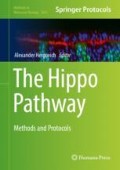Abstract
Immunocytochemistry enables determination of cellular localization and relative abundance of proteins. This protocol describes a rapid and cost-effective approach to study the cellular localization of YAP (and TAZ), the transcriptional co activators of the Hippo pathway, in mammalian cells. Cells are seeded onto coated cover slips, cultivated and treated as required. Subsequently, they are chemically fixed, and cellular proteins are fluorescently labeled by means of specific antibodies. Multiplexing antibodies enables ascertaining the subcellular localization of YAP and TAZ and thereby also the activation state of the Hippo pathway in various cell types.
Access this chapter
Tax calculation will be finalised at checkout
Purchases are for personal use only
References
Hansen CG, Moroishi T, Guan KL (2015) YAP and TAZ: a nexus for Hippo signaling and beyond. Trends Cell Biol 25(9):499–513. https://doi.org/10.1016/j.tcb.2015.05.002
Gomez M, Gomez V, Hergovich A (2014) The Hippo pathway in disease and therapy: cancer and beyond. Clin Transl Med 3(22):1–12. https://doi.org/10.1186/2001-1326-3-22
Gaspar P, Tapon N (2014) Sensing the local environment: actin architecture and Hippo signalling. Curr Opin Cell Biol 31:74–83. https://doi.org/10.1016/j.ceb.2014.09.003
Wada K, Itoga K, Okano T, Yonemura S, Sasaki H (2011) Hippo pathway regulation by cell morphology and stress fibers. Development 138(18):3907–3914. https://doi.org/10.1242/dev.070987
Zhao B, Li L, Wang L, Wang CY, Yu J, Guan KL (2012) Cell detachment activates the Hippo pathway via cytoskeleton reorganization to induce anoikis. Genes Dev 26(1):54–68. https://doi.org/10.1101/gad.173435.111
Yu FX, Zhao B, Panupinthu N, Jewell JL, Lian I, Wang LH, Zhao J, Yuan H, Tumaneng K, Li H, Fu XD, Mills GB, Guan KL (2012) Regulation of the Hippo-YAP pathway by G-protein-coupled receptor signaling. Cell 150(4):780–791. https://doi.org/10.1016/j.cell.2012.06.037
Park HW, Kim YC, Yu B, Moroishi T, Mo JS, Plouffe SW, Meng Z, Lin KC, Yu FX, Alexander CM, Wang CY, Guan KL (2015) Alternative Wnt signaling activates YAP/TAZ. Cell 162(4):780–794. https://doi.org/10.1016/j.cell.2015.07.013
Kim NG, Gumbiner BM (2015) Adhesion to fibronectin regulates Hippo signaling via the FAK-Src-PI3K pathway. J Cell Biol 210(3):503–515. https://doi.org/10.1083/jcb.201501025
Dupont S, Morsut L, Aragona M, Enzo E, Giulitti S, Cordenonsi M, Zanconato F, Le Digabel J, Forcato M, Bicciato S, Elvassore N, Piccolo S (2011) Role of YAP/TAZ in mechanotransduction. Nature 474(7350):179–183. https://doi.org/10.1038/nature10137
Engler AJ, Sen S, Sweeney HL, Discher DE (2006) Matrix elasticity directs stem cell lineage specification. Cell 126(4):677–689. https://doi.org/10.1016/j.cell.2006.06.044
Panciera T, Azzolin L, Cordenonsi M, Piccolo S (2017) Mechanobiology of YAP and TAZ in physiology and disease. Nat Rev Mol Cell Biol 18(12):758–770. https://doi.org/10.1038/nrm.2017.87
Koontz LM, Liu-Chittenden Y, Yin F, Zheng Y, Yu J, Huang B, Chen Q, Wu S, Pan D (2013) The Hippo effector Yorkie controls normal tissue growth by antagonizing scalloped-mediated default repression. Dev Cell 25(4):388–401. https://doi.org/10.1016/j.devcel.2013.04.021
Jiao S, Wang H, Shi Z, Dong A, Zhang W, Song X, He F, Wang Y, Zhang Z, Wang W, Wang X, Guo T, Li P, Zhao Y, Ji H, Zhang L, Zhou Z (2014) A peptide mimicking VGLL4 function acts as a YAP antagonist therapy against gastric cancer. Cancer Cell 25(2):166–180. https://doi.org/10.1016/j.ccr.2014.01.010
Zhang W, Gao Y, Li P, Shi Z, Guo T, Li F, Han X, Feng Y, Zheng C, Wang Z, Li F, Chen H, Zhou Z, Zhang L, Ji H (2014) VGLL4 functions as a new tumor suppressor in lung cancer by negatively regulating the YAP-TEAD transcriptional complex. Cell Res 24(3):331–343. https://doi.org/10.1038/cr.2014.10
Hansen CG, Ng YL, Lam WL, Plouffe SW, Guan KL (2015) The Hippo pathway effectors YAP and TAZ promote cell growth by modulating amino acid signaling to mTORC1. Cell Res 25(12):1299–1313. https://doi.org/10.1038/cr.2015.140
Acknowledgments
Members of the Gram Hansen lab are thanked for their comments as well as for helping taking the photos for Figs. 1, 2, 3, 4, 5, and 6. Work ongoing in the Gram Hansen lab is supported by a Chancellor’s Fellowship start-up fund and by the Wellcome Trust-University of Edinburgh Institutional Strategic Support Fund. We acknowledge the technical support and guidance provided by the Centre for Reproductive Health SuRF Histology and imaging as well as the Centre for Inflammation Research imaging staff.
Author information
Authors and Affiliations
Corresponding author
Editor information
Editors and Affiliations
Rights and permissions
Copyright information
© 2019 Springer Science+Business Media, LLC, part of Springer Nature
About this protocol
Cite this protocol
Rausch, V., Hansen, C.G. (2019). Immunofluorescence Study of Endogenous YAP in Mammalian Cells. In: Hergovich, A. (eds) The Hippo Pathway. Methods in Molecular Biology, vol 1893. Humana Press, New York, NY. https://doi.org/10.1007/978-1-4939-8910-2_8
Download citation
DOI: https://doi.org/10.1007/978-1-4939-8910-2_8
Published:
Publisher Name: Humana Press, New York, NY
Print ISBN: 978-1-4939-8909-6
Online ISBN: 978-1-4939-8910-2
eBook Packages: Springer Protocols

